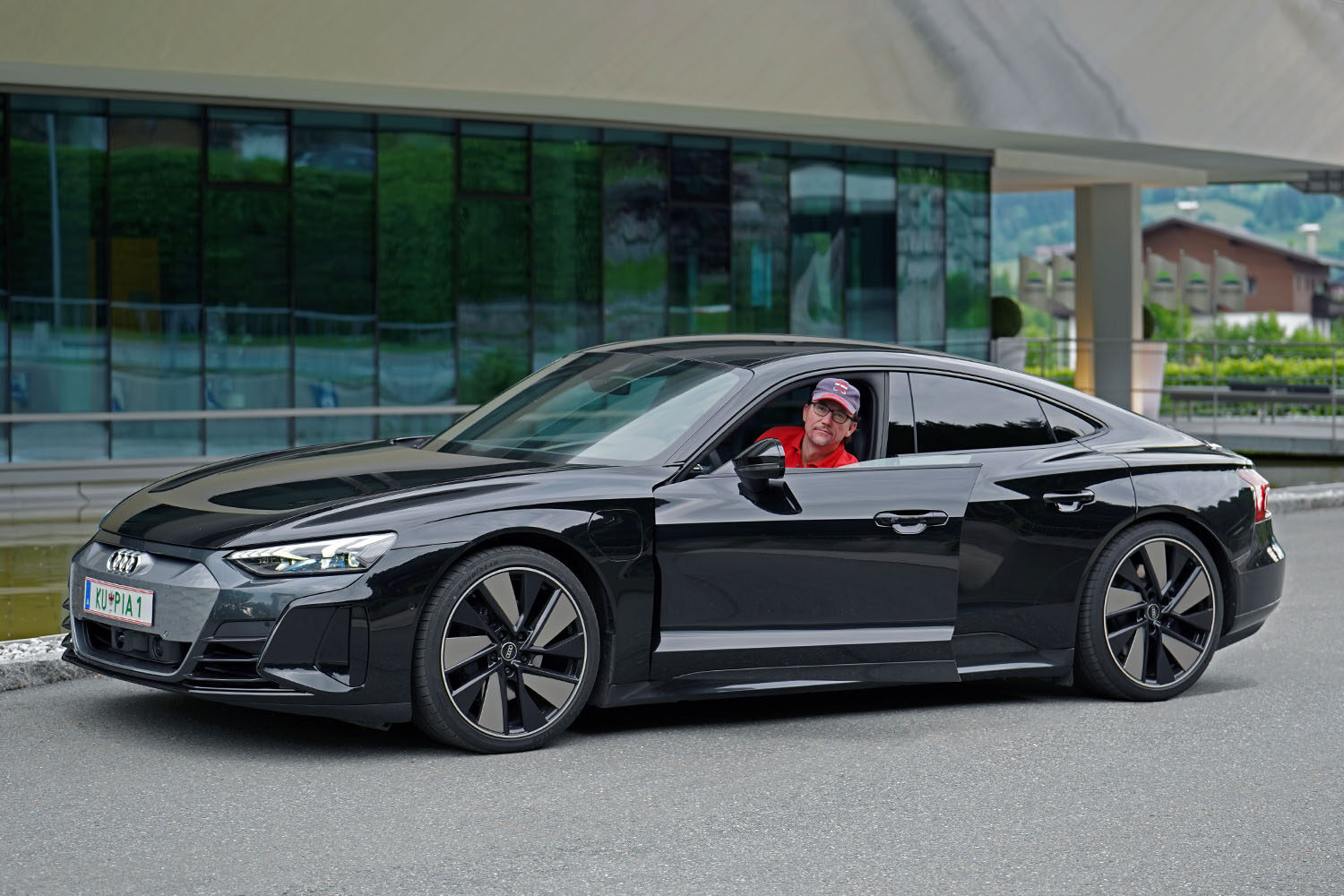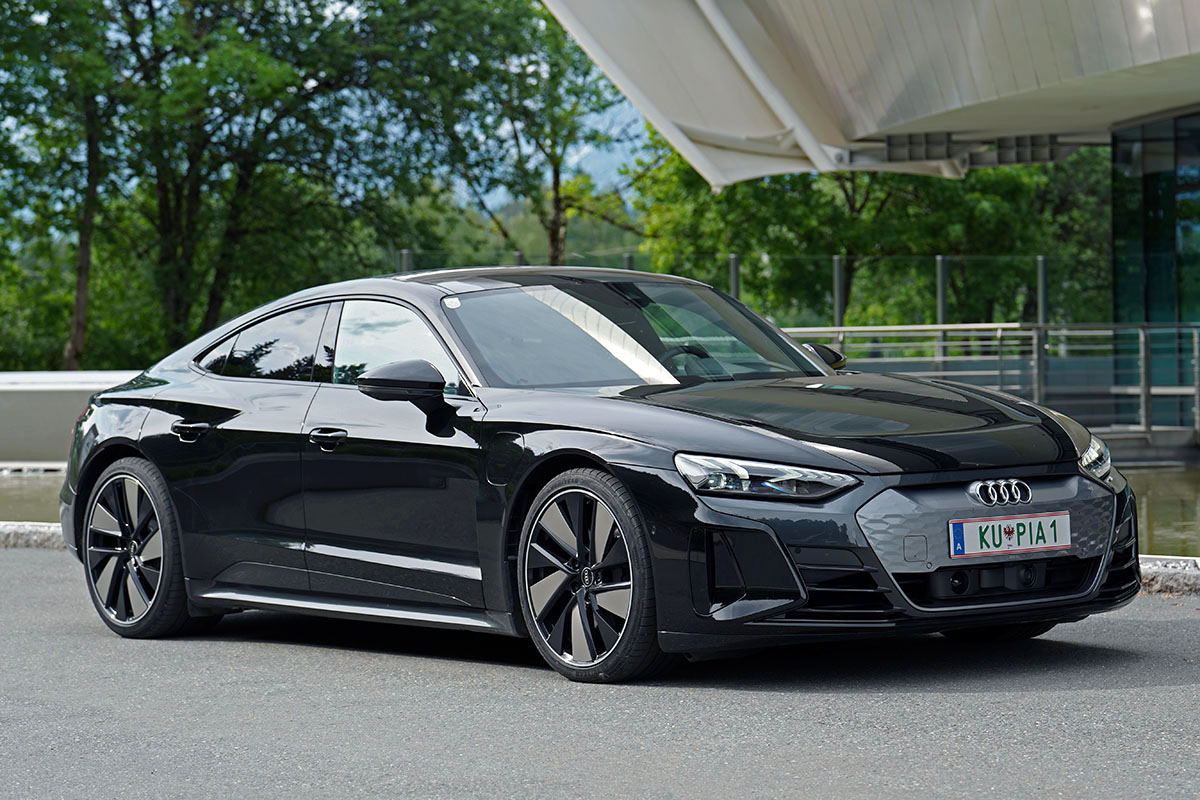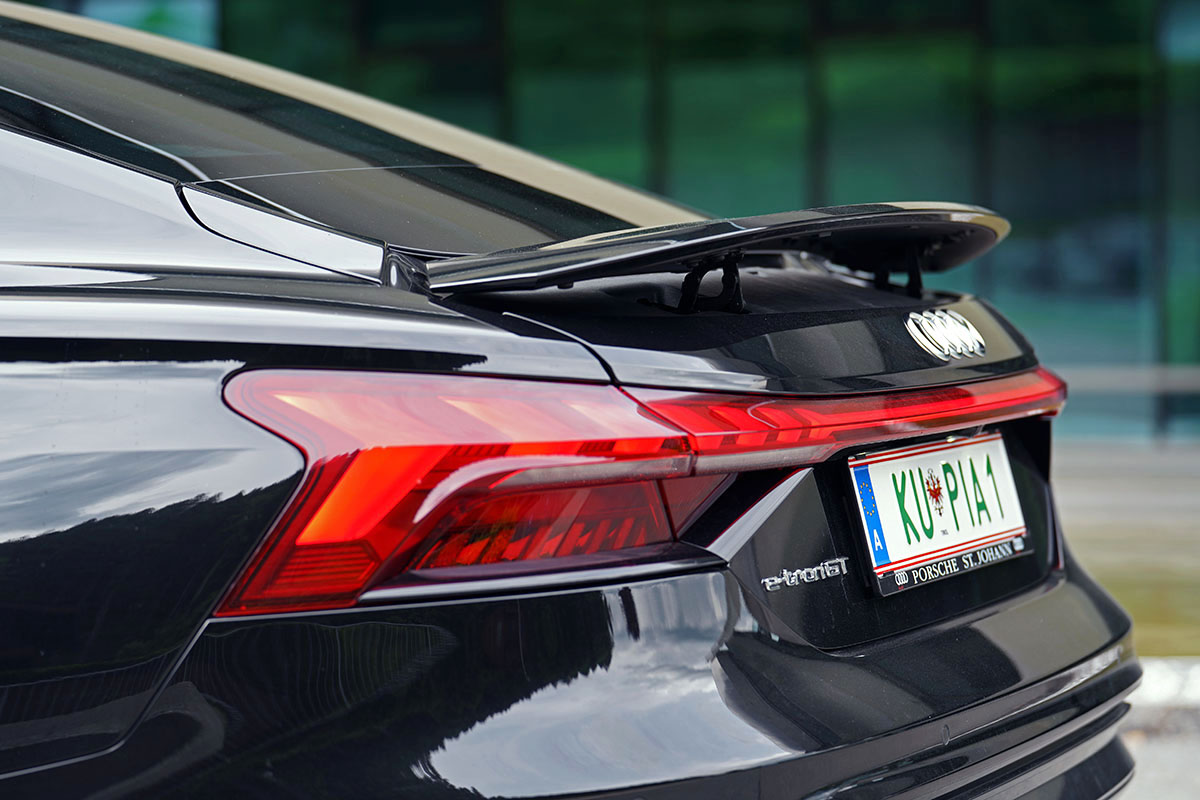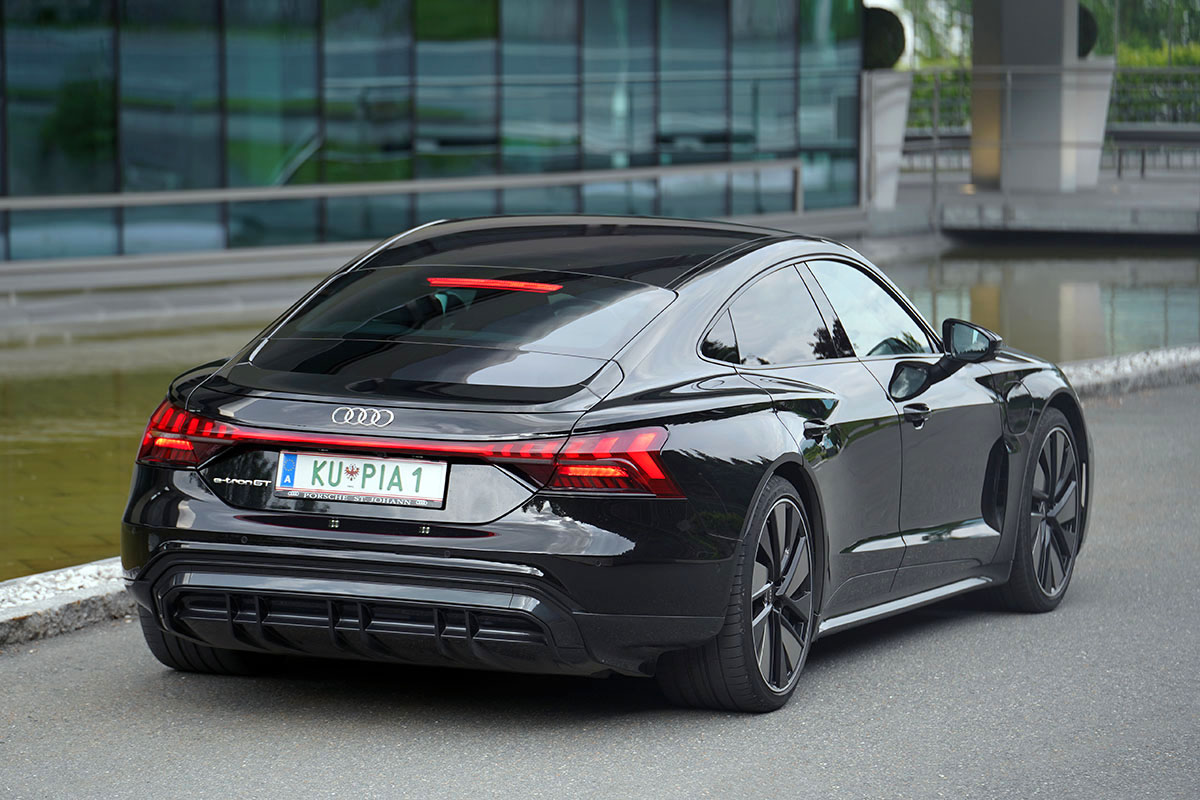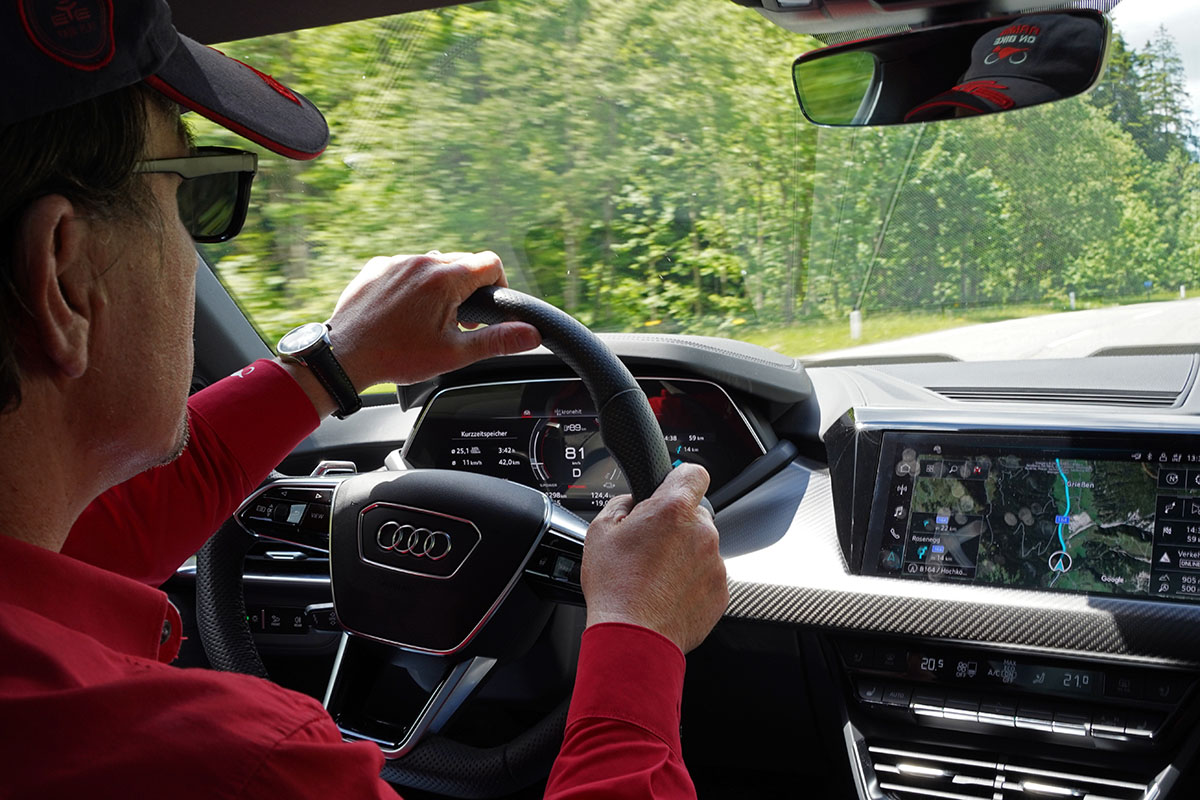St. Johann in Tyrol – Audi is expanding its purely electric-powered range with a gran turismo. The all-wheel drive e-tron GT, which is also offered in an RS version, is the most powerful EV to date by the Ingolstadt-based manufacturer. Despite the limited availability at present, I managed to get my hands on a car to test for you…
The Porsche Inter Auto car dealership sells vehicles from the Volkswagen Group at 53 locations across Austria. The Porsche St. Johann branch, with director Andreas Maier and Audi brand manager Alexander Duller, supplied me with the new Audi e-tron GT quattro in “Mythos Black, Metallic” for my test. An impressive sight with its flat, sweeping silhouette and widened wheel arches. The tyre dimensions on the 21” alloys are 265/35 on the front and 305/30 on the rear. The flowing design runs from the elongated bonnet over the flush windscreen before the coupé-like roof line gently slopes down again. With its elegant yet dynamic design, Audi is going into a new era in terms of its design language.
AUDI SPORT IN AN EV
And just like that, I was sitting in the car that Tony Stark aka Ironman drove in “Avengers: Endgame”. The futuristic, turbine-like noise coming from its dedicated sound generator fits the aesthetic. You sit low to the ground like in a sports car. The battery system and electric motors, which sit underneath the cockpit, give the e-tron GT a very low centre of gravity. The weight distribution being close to 50:50 contributes to the car’s sporty character. This was immediately apparent to me during my test. The five-metre-long GT sat so stably on the road that I could only guess at the speed I was taking corners. The air suspension assures for the optimal chassis setup depending on the situation and all-wheel steering contributes to dynamic driving behaviour. The wheels turn in the opposite direction up to 50 km/h (31 mph) and in the same direction from 80 km/h (50 mph), thereby shrinking the turning circle by 0.6 metres, which made a good impression when manoeuvring. An additional technical feature is the controlled rear axle differential lock, which improves traction and steering behaviour with targeted braking intervention. I had the feeling that the car could just dive into the bends. The PSM (Permanent Magnet Synchronous) motors on the front and rear axles, which have a combined system output of 350 kW (469 hp) and 630 Nm (465 ft-lb) of torque, propel the 2,351 kg GT from 0 to 100 km/h (62 mph) in 4.5 seconds. The all-wheel drive constantly fine-tunes power distribution between the two axles. With boost in Launch Control an additional 40 kilowatt of power is provided for 2.5 seconds, which shortens the sprint to 100 km/h (62 mph) to 4.1 seconds. A breathtaking experience, I can’t describe it any other way. The top speed is electronically limited to 245 km/h (152 mph). The matrix LED headlights with laser light give illumination in darkness almost like real daylight. Laser spots in the centre of the headlights make the bulbs double their range above 70 km/h (43 mph). When oncoming cars are detected by the camera behind the front windscreen, the lights dim just in that area.
INTELLIGENT AERODYNAMICS
Great worth has been placed all around the vehicle along with its streamlined form. Front-end cooling inlets only open as required so as to get the most time with the perfect amount of headwind. Two electrical shutters in the Singleframe grille are adjustable and controlled independently from one another. The e-tron GT’s rear end features a continuous LED light strip and rear spoiler, which raises to two positions depending on speed. Together with the fully faired underside, which merges into a prominent diffuser, the GT has optimal streamlining and rear downforce. Air suspension lowers the body at 90 km/h (56 mph) by 10 mm and by a further 12 mm at 180 km/h (112 mph). The result is that the GT boasts an excellent 0.24 cd.
PREMIUM INTERIOR
On the inside the sporty seats are upholstered with perforated leather and honeycomb stitching. In my case, in Monaco Grey with grey accents. The electrically adjustable seat moves back and the steering wheel rises before jumping in, ensuring comfortable entry. The front seats are not only heated, but also have seat ventilation. These seats work by sucking air in. The pleasant massage function has 8 different programme settings. The dashboard has a surprisingly classic design, without any futuristic accenting. A 12.3-inch colour display is fitted as an instrument display, with which you can select different views. In the middle of the centre console, which is slightly oriented towards the driver, there is a 10.1-inch TFT touch display, where almost all the car’s functions can be controlled. Climate control can also be operated with the control panel below the screen. The carbon decor supports Audi’s claim to having high tech interiors. The Bang & Olufsen sound system, with a 710-watt output and 16 speakers, makes sure passengers will not be disappointed. The smartphone holder with wireless charging capabilities is positioned quite far back on the armrest, which means getting to your phone can be a bit fiddly.
800-VOLT BATTERY
The Porsche Taycan was the first production vehicle with a system voltage of 800 volts. Now, the Audi e-tron GT is following in its footsteps, which is based on the same J1 performance platform. The advantages over the 400-volt system, which has been standard until now, is evident. Charging time has been cut, the weight and space required for wiring has been reduced, and it makes a huge range increase possible. The GT’s lithium-ion battery offers a storage capacity of 93.4 kWh (gross), of which 83.7 kWh (net) is usable. A complex cooling system with four separate coolant circuits regulate the temperature of the high-voltage system and the cabin. In colder outside temperatures, a heat pump helps to save energy by using waste heat energy from the drivetrain to warm the car’s interior.
NORMAL AC CHARGING
Charging with a household socket works with a maximum charging rate of 2.3 kW. Charging a battery with such a high net capacity is naturally a longer process. It would take about 50 hours to reach full charge. A range of 60 miles is attainable in 12 hours of overnight charging, which is more than enough for daily journeys. In terms of production-line charging equipment, you can choose between household and industrial plugs. With the latter, it is possible to charge at a rate of up to 11 kW with a three-phase mains charger. The best available Connect charging system doubles this figure to 22 kW. Both systems can be used with a mounted wall box which is available separately.
In the garage at the MPREIS supermarket in Kitzbühel I used a type 2 charging station at 11 kW, powered by TIWAG-Tiroler Wasserkraft AG (hydroelectric energy company). The GT is equipped with two charging ports for better accessibility. The 11-kW on-board charger has the option of 22 kW when you order. The expanded CCS (Combined Charging System) DC charging socket is only fitted on the right-hand side. I began charging at 35% SoC (State of Charge). From the word go the car charged at a rate of 10 kW according to the cockpit display. After finishing it showed on the charging station meter that it had charged 5.85 kW in 31 minutes, which would give a charging rate of 11.34 kW. The differing values would most likely trace back to loss of charge. It would have taken approximately 6.5 hours to charge from 0-80% SoC.
DC FAST CHARGING UP TO 263 KW
Audi promises a charging rate of up to 270 kW in their technical data. Having arrived at the Angath Nord service station in the Kufstein district, I was curious whether this would be possible at the IONITY charging station, run together with location partner OMV. And in fact, it was. The charging process started at 3% SoC at 244 kW. Only at 27% charge did the displayed charging power reach its maximum rate of 263 kW and stayed above 200 kW until 60% SoC, before falling to 83 kW at 80%. After exactly 20 minutes and 5 seconds it reached 80% and 69 kWh charged. This meant it achieved an impressive average charging rate of 207 kW. According to the instrument display I had gained 418 km (260 miles) range in that time, which would have worked out to 100 km (62 miles) in under 5 minutes. Since the range was sitting on roughly 400 km (250 miles) with a full battery charge according to my average test usage, then in practice 80% should cover about 320 km (200 miles). This would mean that charging for 6 minutes 40 seconds would add 100 km (62 miles) to the range.
A nationwide charging network with ultra-fast charging (300-350 kW), which would allow the full utilisation of the e-tron GT’s maximum charging speed, is currently under construction in Austria. According to information provided by the company. there are currently 15 IONITY charging locations with 78 such charging points in total. An additional location is currently being built. With SMATRICS EnBW there are currently 18 locations with 65 charging points. The company has shared with me that another 60 charging points are due in the coming months. Personally, the situation for me is that from my home in PillerseeTal the closest ultra-fast charging station is 50 kilometres (30 miles) away in one direction and 63 kilometres (39 miles) away in the other.
ARMIN ELECTRIC CONCLUSION
All in all, a real sports car feeling came out during this test, everything from the seat position and the impressive way it plants itself on the road, to the outstanding driving performance. The comfortable interior is upholstered in the finest materials, usability, apart from the smartphone holder, has been exceptional. The Audi e-tron GT quattro is fully equipped for long journeys, thanks to greater battery capacity and shorter charging times. For the most part I tested it on main roads. Average consumption amounted to 21.7 kW/100 km (62 miles), which meant a range of almost 400 km (250 miles). The price for this premium EV starts at €101,400 in Austria (£80,850 in the UK). With the extensive extras which came on the test car, the price comes in at almost €140,000. The list of optional extras is long, some of which I would have expected as standard considering the already high starting price. Audi is aiming to offer only electric vehicles in its range from 2033. Today, the e-tron GT makes their vision a little bit more imaginable.
Text and photos: Armin Hoyer – arminonbike.com
Photos with Armin: Dagmar Berger

